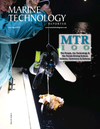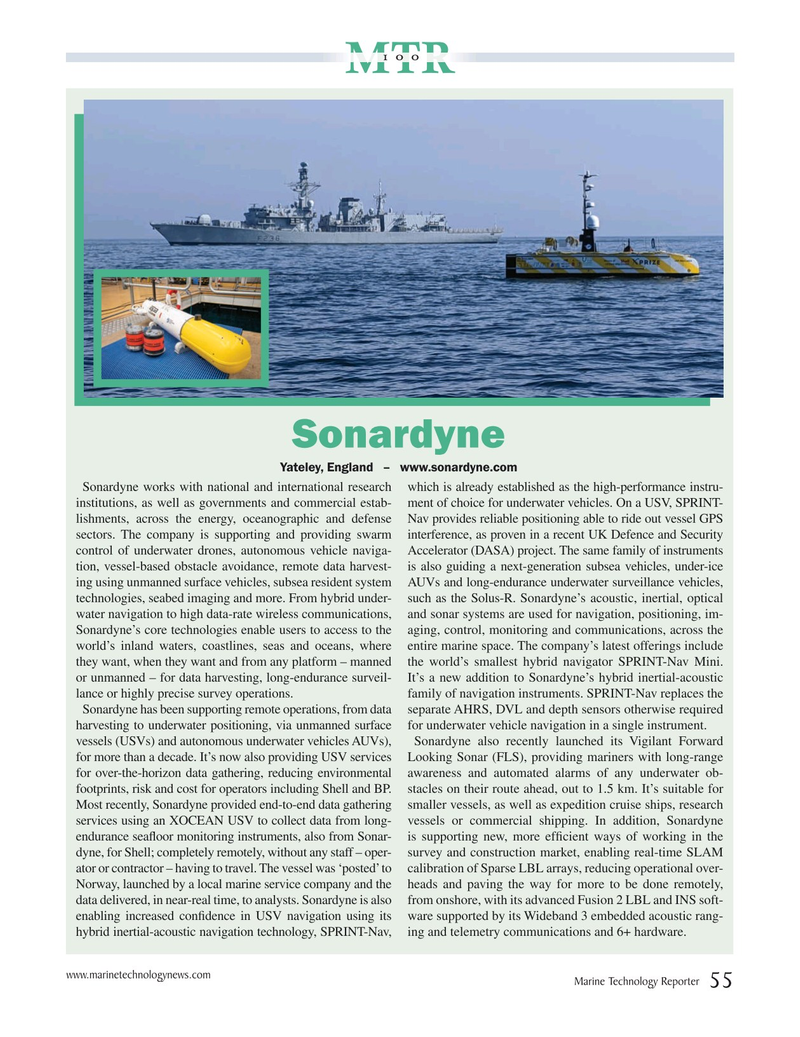
Page 55: of Marine Technology Magazine (July 2020)
Read this page in Pdf, Flash or Html5 edition of July 2020 Marine Technology Magazine
100
MTRMTR
Sonardyne
Yateley, England – www.sonardyne.com
Sonardyne works with national and international research which is already established as the high-performance instru- institutions, as well as governments and commercial estab- ment of choice for underwater vehicles. On a USV, SPRINT- lishments, across the energy, oceanographic and defense Nav provides reliable positioning able to ride out vessel GPS sectors. The company is supporting and providing swarm interference, as proven in a recent UK Defence and Security control of underwater drones, autonomous vehicle naviga- Accelerator (DASA) project. The same family of instruments tion, vessel-based obstacle avoidance, remote data harvest- is also guiding a next-generation subsea vehicles, under-ice ing using unmanned surface vehicles, subsea resident system AUVs and long-endurance underwater surveillance vehicles, technologies, seabed imaging and more. From hybrid under- such as the Solus-R. Sonardyne’s acoustic, inertial, optical water navigation to high data-rate wireless communications, and sonar systems are used for navigation, positioning, im-
Sonardyne’s core technologies enable users to access to the aging, control, monitoring and communications, across the world’s inland waters, coastlines, seas and oceans, where entire marine space. The company’s latest offerings include they want, when they want and from any platform – manned the world’s smallest hybrid navigator SPRINT-Nav Mini. or unmanned – for data harvesting, long-endurance surveil- It’s a new addition to Sonardyne’s hybrid inertial-acoustic lance or highly precise survey operations. family of navigation instruments. SPRINT-Nav replaces the
Sonardyne has been supporting remote operations, from data separate AHRS, DVL and depth sensors otherwise required harvesting to underwater positioning, via unmanned surface for underwater vehicle navigation in a single instrument. vessels (USVs) and autonomous underwater vehicles AUVs), Sonardyne also recently launched its Vigilant Forward for more than a decade. It’s now also providing USV services Looking Sonar (FLS), providing mariners with long-range for over-the-horizon data gathering, reducing environmental awareness and automated alarms of any underwater ob- footprints, risk and cost for operators including Shell and BP. stacles on their route ahead, out to 1.5 km. It’s suitable for
Most recently, Sonardyne provided end-to-end data gathering smaller vessels, as well as expedition cruise ships, research services using an XOCEAN USV to collect data from long- vessels or commercial shipping. In addition, Sonardyne endurance sea? oor monitoring instruments, also from Sonar- is supporting new, more ef? cient ways of working in the dyne, for Shell; completely remotely, without any staff – oper- survey and construction market, enabling real-time SLAM ator or contractor – having to travel. The vessel was ‘posted’ to calibration of Sparse LBL arrays, reducing operational over-
Norway, launched by a local marine service company and the heads and paving the way for more to be done remotely, data delivered, in near-real time, to analysts. Sonardyne is also from onshore, with its advanced Fusion 2 LBL and INS soft- enabling increased con? dence in USV navigation using its ware supported by its Wideband 3 embedded acoustic rang- hybrid inertial-acoustic navigation technology, SPRINT-Nav, ing and telemetry communications and 6+ hardware. www.marinetechnologynews.com
Marine Technology Reporter 55
MTR #6 (50-63).indd 55 8/13/2020 9:35:42 AM

 54
54

 56
56
